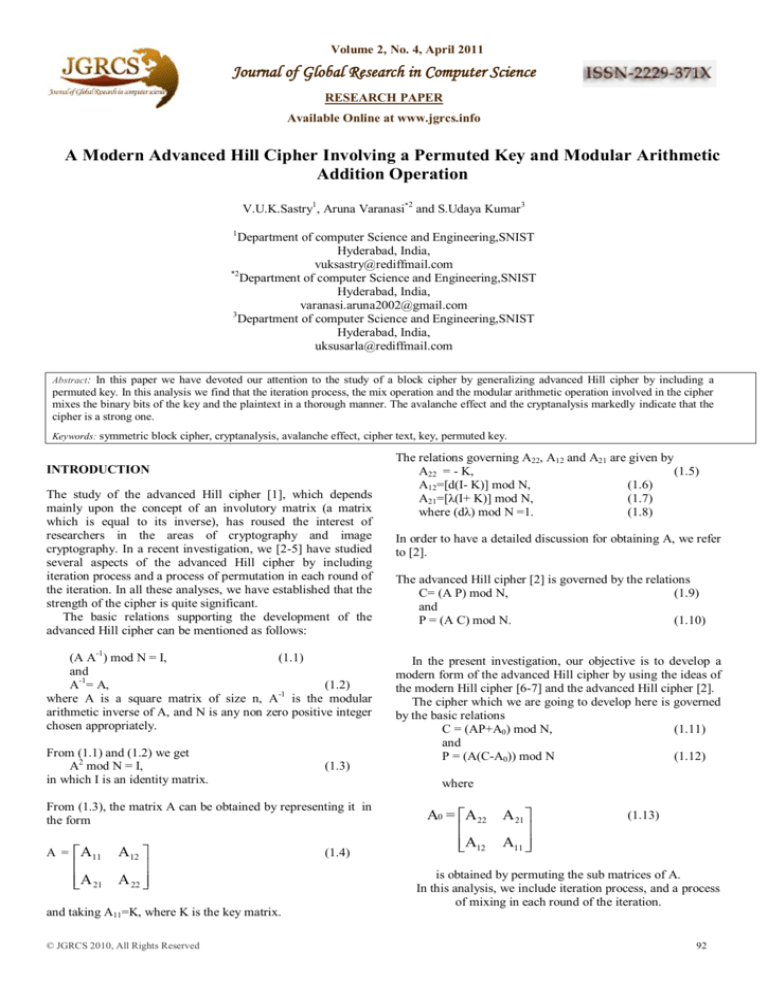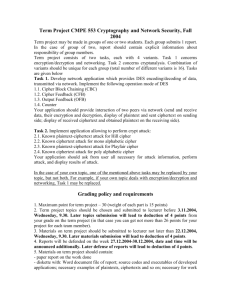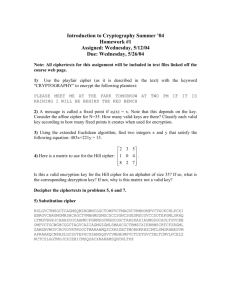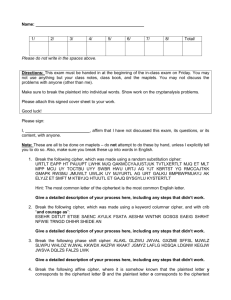
Volume 2, No. 4, April 2011
Journal of Global Research in Computer Science
RESEARCH PAPER
Available Online at www.jgrcs.info
A Modern Advanced Hill Cipher Involving a Permuted Key and Modular Arithmetic
Addition Operation
V.U.K.Sastry1, Aruna Varanasi*2 and S.Udaya Kumar 3
1
Department of computer Science and Engineering,SNIST
Hyderabad, India,
vuksastry@rediffmail.com
*2
Department of computer Science and Engineering,SNIST
Hyderabad, India,
varanasi.aruna2002@gmail.com
3
Department of computer Science and Engineering,SNIST
Hyderabad, India,
uksusarla@rediffmail.com
Abstract: In this paper we have devoted our attention to the study of a block cipher by generalizing advanced Hill cipher by including a
permuted key. In this analysis we find that the iteration process, the mix operation and the modular arithmetic operation involved in the cipher
mixes the binary bits of the key and the plaintext in a thorough manner. The avalanche effect and the cryptanalysis markedly indicate that the
cipher is a strong one.
Keywords: symmetric block cipher, cryptanalysis, avalanche effect, cipher text, key, permuted key.
INTRODUCTION
The study of the advanced Hill cipher [1], which depends
mainly upon the concept of an involutory matrix (a matrix
which is equal to its inverse), has roused the interest of
researchers in the areas of cryptography and image
cryptography. In a recent investigation, we [2-5] have studied
several aspects of the advanced Hill cipher by including
iteration process and a process of permutation in each round of
the iteration. In all these analyses, we have established that the
strength of the cipher is quite significant.
The basic relations supporting the development of the
advanced Hill cipher can be mentioned as follows:
(A A-1) mod N = I,
(1.1)
and
A-1= A,
(1.2)
where A is a square matrix of size n, A-1 is the modular
arithmetic inverse of A, and N is any non zero positive integer
chosen appropriately.
From (1.1) and (1.2) we get
A2 mod N = I,
in which I is an identity matrix.
(1.3)
A11
A12
A 21
A 22
and taking A11=K, where K is the key matrix.
© JGRCS 2010, All Rights Reserved
In order to have a detailed discussion for obtaining A, we refer
to [2].
The advanced Hill cipher [2] is governed by the relations
C= (A P) mod N,
(1.9)
and
P = (A C) mod N.
(1.10)
In the present investigation, our objective is to develop a
modern form of the advanced Hill cipher by using the ideas of
the modern Hill cipher [6-7] and the advanced Hill cipher [2].
The cipher which we are going to develop here is governed
by the basic relations
C = (AP+A0) mod N,
(1.11)
and
P = (A(C-A0)) mod N
(1.12)
where
From (1.3), the matrix A can be obtained by representing it in
the form
A =
The relations governing A22, A12 and A21 are given by
A22 = - K,
(1.5)
A12=[d(I- K)] mod N,
(1.6)
A21=[λ(I+ K)] mod N,
(1.7)
where (dλ) mod N =1.
(1.8)
(1.4)
A0 = A 22
A 21
A12
A11
(1.13)
is obtained by permuting the sub matrices of A.
In this analysis, we include iteration process, and a process
of mixing in each round of the iteration.
92
V.U.K.Sastry et al, Journal of Global Research in Computer Science, 2 (4), April 2011
Now let us mention the plan of the paper. In section 2, we
have introduced the development of the cipher and presented
the flow charts and algorithms for the encryption and the
decryption. We have illustrated the cipher with a suitable
example in section 3. Further, we have studied the avalanche
effect in this section. Then we have carried out the
cryptanalysis in section 4. Finally in section 5, we have
devoted our attention to computations and conclusions.
DEVELOPMENT OF THE CIPHER
Let us consider a plaintext, P. On using EBCDIC code, let P
be written in the form of a matrix given by
P = [Pij], i= 1 to n, j=1 to n,
(2.1)
where n is any positive even integer, and each element of P is a
decimal number lying between 0 and 255.
Let us take a key matrix K, which can be represented in the
form
K = [Kij], i=1 to n/2, j=1 to n/2,
(2.2)
where each Kij is also a decimal number in the interval 0 to
255.
On using (1.4), taking the key matrix K, we get the matrix
A. Then the ciphertext C can be written in the form
C = (AP+A0) mod N,
(2.3)
where N= 256, and A0 is obtained from (1.13).
Here we take C = [Cij], i= 1 to n, j=1 to n.
The flow chart describing the cipher is given in Fig.1
for obtaining A0. The function Imix() denotes the reverse
process of mix(). The detailed discussion of mix is given
later.
The algorithms for encryption and decryption are written
below.
Algorithm for Encryption
1.
2.
3.
4.
5.
Read n,P,K,r,d
A11 = K
A = involute(A11,d)
A0=permute(A)
for i = 1 to r
{
P = (A P + A0) mod 256
P= mix(P)
}
C=P
6. Write( C )
Algorithm for Decryption
1.
2.
3.
4.
4.
Read n,C,K,r,d
A11 = K
A = involute(A11,d)
A0=permute(A)
for i= 1 to r
{
C = Imix(C)
C= ( A (C-A0 ))mod 256
}
P=C
4. Write (P)
In the above algorithms „r‟ indicates the number of rounds.
Let us now consider the process of mixing, represented by
the function mix(), in the encryption algorithm. In each stage
of the iteration process, the plaintext matrix P is of size nxn,
where each element can be represented in terms of eight binary
bits. Thus the entire matrix can be written in the form of a
string of binary bits containing 8n2 bits. Here, this string is
divided into four substrings wherein each one is of size 2n2
binary bits. These strings can be written in the form
In this, the function involute() includes the procedure, given
by the relations (1.4) – (1.8), for obtaining the involutory
matrix A. Here, we have included iteration process and the
function mix() in each round of the iteration process to
achieve thorough confusion and diffusion in arriving at the
ciphertext. Further, here we have used the function permute()
© JGRCS 2010, All Rights Reserved
q1 q 2
q3
q4 . . . . q
r1
r2
r3
r4
. . . . r
s1
s2
s3
s4
. . . . s
t1
t2
t3
t4
. . . . t
,
2n 2
2n 2
2n 2
2n 2
,
,
.
Here, the mixing is done by arranging the binary bits of the
different substrings as shown below:
93
V.U.K.Sastry et al, Journal of Global Research in Computer Science, 2 (4), April 2011
q1 r1 s1 t1 q2 r2 s2 t 2 q3 r3 s3 t 3 q4 r4 s4 t 4 . . . . . . q
2n 2
r
2n 2
s
2n 2
t
2n 2
. 123 . 25.. 9
134 17
Then this is decomposed into n2 substrings by considering 8
bits at a time in order. On writing each substring in the form of
a decimal number, we get a square matrix of size n.
ILLUSTRATION OF THE CIPHER
Consider the plaintext given below:
210 85
11
46
133 23
208 68
191
48 199 209 75
112 11
39
55
235 187 33
84
83 163 161 133 231 247 189
66
70
A= 16
“Dear! Where are you? How are you? I have been waiting for
your arrival with wide open eyes. Your mother and father are
visiting several houses and seeing several matches for you. Of
course I have got my belief in you and our love and affection
are eternal. I know this fact and wait for you.”
(3.1)
20
67
85
92
220 57
231 63
207
122 239 236 245
77 134 249 208 57
109 29
144 255
47
181
217 201 171 164
From this, on using (1.13), we get
We focus our attention on the first sixty four characters of the
plaintext (3.1). This is given by
“Dear! Where are you? How are you? I have been waiting for
your a”
(3.2)
133 231 247 189 84
83 163 161
122 239 236 245 66
70
208 57
77 134 249
On using the EBCDIC code, the plaintext under consideration
can be written in the form
217 201 171 164 109 29
231 63
210 85
9
67
20
11
196 133 129 153 79
133 153 133 64
64
129 153 133 64
64
201 64
230 136
134 150
168 150 164 153 64
(3.3)
207 39
55
85
129
251 11
9
67
20
11
(3.4)
5
105 173 143 204 145
193 115 144 83 153 214 71
43
156 207 113 92
68
2
49
251 11
122 165 12
120 124 241 0
22
217 250 4
48
199 209 75
73
39
55
69 166 161 70
31
185 187 131 79
68 147 41
91
89
85
(3.6)
92
Now, on using A, A0 and P, given by (3.5),(3.6) and (3.3),
and the encryption algorithm, with r=16, we get the ciphertext
C. This is given by
Let us take the key K in the form
134 17
191 134 17
144 255 48 199 209 75
235 187 33
168 150 164
P = 137 163 137 149 135 64
25
123 25
136 129 165 133
166 129
K = 123
181 16
133 23
208 68
A0= 112 11
200 150 166
130 133 133 149 64
153 64
46
47
220 57
129 153 133 64
168 150 164 111 64
111 64
64
(3.5)
92
On using the relations (1.4) - (1.8) and taking d=99, we get
C=
5
211 162 57
17
3
205 243 215
84
(3.7)
209 252 127
On using (3.5), (3.6) and (3.7), and applying the decryption
algorithm, we get back the original plaintext given by (3.3).
Let us now focus our attention on the avalanche effect, which
yields a measure regarding the strength of the cipher.
To carry out this one, firstly we replace the ninth character
„e‟ of the plaintext (3.2) by„d‟. The EBCDIC codes of„d ‟ and
„e ‟ are 132 and 133 . On converting these two numbers into
their binary form, we find that they differ by one bit. On using
the plaintext, including afore mentioned modification, the A
© JGRCS 2010, All Rights Reserved
94
V.U.K.Sastry et al, Journal of Global Research in Computer Science, 2 (4), April 2011
and A0 given by (3.5) and (3.6), we apply the encryption
algorithm, and find the ciphertext C. Thus we have
142 183 242 74
187 174 88
25
148 111 197 73
126 7
251 13
32
58
222
246 141 187 200 159
148 106 193 178 30
203 233 229
141 205 193 164 237 223 46
200
169 235 60
204
C = 127 47
249 1
223 79
240 22
5
8
169 246 99
164 201 81
22
125
(3.8)
195 152
On comparing (3.7) and (3.8), in their binary form, we
notice that the two ciphertexts differ by 260 binary bits (out of
512 bits). This indicates that the cipher is a strong one.
Let us now focus our attention on a one bit change in the
key K. In order to achieve this one, we replace the first row
fourth column element “ 67 ” of (3.4), by “ 66 ”. After
obtaining A and the corresponding A0, we perform the
encryption (using the original plaintext). Thus we get the
ciphertext given by
82
199 217 55
197 14
69
108 193 39
67
65
213 88
76
105 28
180 46
197 185
114 199 245 174 223 130 9
112
79 115 94
44
127 148 24
33 111 186 212 52
82
25
100 115 122 106 37
51
127 119
74
(3.9)
128
Now on comparing (3.7) and (3.9), in their binary form, we
find that they differ by 278 bits (out of 512 bits). This also
thoroughly suggests that the cipher is a potential one.
CRYPTANALYSIS
The cryptanalytic attacks which are generally considered in the
literature of Cryptography are
1. Ciphertext only attack (Brute force attack) 2)
Known plaintext attack
3) Chosen plaintext attack and
4) Chosen ciphertext attack
In all these attacks, the primary objective is to determine
either the key or a function of the key so that the cipher can be
broken. This is the desire of the cryptanalyst.
© JGRCS 2010, All Rights Reserved
If the time required for obtaining the plaintext with one
value of the key in the key space is 10-7 seconds, then the time
for carrying out the determination of the plaintext with all the
possible keys in the key space is
10 40 . 8× 10− 7
= 3. 171× 10 25 .8 years
365× 24× 60× 60
As this number is a formidable one, it is simply impossible
to break the cipher by this attack.
In the case of the known plaintext attack, we have as many
pairs of plaintext and ciphertext as we wish. In this analysis, as
we have the prominent features, namely, iteration, mixing and
modular arithmetic addition operation, involving A0, by the
time we reach the final stage of the iteration process, we get a
relation between the ciphertext, the involutory matrix A (
including the key K) and the original plaintext P in the form
C =M((AM((……. M( (A M((AP + A0) mod 256) + A0 ) mod
256) ……..+A0)mod256)+A0)mod256)
140
247 186 101 101 110 227 118
106 76
C=
3
Let us now consider, firstly, the ciphertext only attack. In
this analysis the key K, given by (3.4), is consisting of 16
numbers wherein each number can be represented in the form
of 8 binary bits. In addition to this key, we have made use of
an integer„d‟, which can be considered as an additional key, in
the development of the involutory matrix, A. This key
requires eight more binary bits, and hence the total length of
the key, which controls the cipher, is 136 bits. Thus the size of
the key space is
2136 = (210 )13 . 6≈ (103 )13 . 6 =1040.8 .
for r=16.
(4.1)
In the above relation, A0 is obtained by permuting A, see
(1.13), and the M() stands for the function mix(). In (4.1) the
matrix A (containing the key K) is multiplied with the
plaintext P, and it is added to A0. Then mixing is carried out
after performing the mod 256. On account of this sort of
operations, the binary bits of the key and the plaintext are
thoroughly mixed at various stages, and hence it is impossible
to decipher the key or a function of the key, which enables the
cryptanalyst to break the cipher. From this we conclude that
the cipher cannot be broken by the known plaintext attack.
With all effort, basing upon intuition, no special choice of
either the plaintext or the ciphertext appears to yield a scope
for breaking the cipher.
In the light of the above discussion of cryptanalysis, we
firmly conclude that the cipher is a strong one, and it cannot be
broken by any means.
COMPUTATIONS AND CONCLUSIONS
In this paper, we have developed a block cipher called modern
advanced Hill cipher. In this the Hill cipher has taken a very
refined shape from the view point of the analysis and the
strength of the cipher.
Here the computations are carried out by writing programs
for encryption and decryption in Java.
95
V.U.K.Sastry et al, Journal of Global Research in Computer Science, 2 (4), April 2011
The ciphertext corresponding to the complete plaintext,
given by (3.1), is obtained in the form
From the significance of the avalanche effect and the
consideration of the cryptanalysis, here it is interesting to note
that this block cipher is a strong one, and it is quite
comparable with any other block cipher in all respects.
In this analysis A0 is obtained by permuting A in a particular
manner. Here it is to be noted that A0 can be obtained in many
other ways by permuting A. For example A0 can be taken as
AT(transpose of A) or it can be obtained by interchanging rows
and or columns in any desired fashion.
REFERENCES
In obtaining this ciphertext, we have divided the plaintext
(3.1) into five blocks. Of course, in the last block we have
added twenty nine blank characters to make it a complete
block.
© JGRCS 2010, All Rights Reserved
[1] Bibhudendra Acharya. Saroj Kumar Panigrahy, Sarat
Kumar Patra, and Ganapathi Panda, “ Image Encryption
Using Advanced Hill Cipher Algorithm”, International
Journal of Recent Trends in Engineering, Vol.1, No.1,
May2009.
[2] V.U.K.Sastry, Aruna Varanasi, S.Udaya Kumar,
“Advanced Hill Cipher Involving Permutation and
Iteration”, International Journal of Advanced Research in
Computer Science, Vol.1, No.4, pp. 141-145, Nov-Dec.
2010.
[3] V.U.K.Sastry, Aruna Varanasi, S.Udaya Kumar,
“Advanced Hill Cipher Handling the Entire Plaintext as a
Single Block”, International Journal of Advanced Research
in Computer Science, Vol.1, No.4, pp. 180-184, Nov-Dec.
2010.
[4] V.U.K.Sastry, Aruna Varanasi, S.Udaya Kumar,
“Advanced Hill Cipher Involving a Key Applied on Both
the Sides of the Plaintext”, International Journal of
Computational Intelligence and Information Security,Vol.
1 No. 9, pp. 70-78, November 2010.
[5] V.U.K.Sastry, Aruna Varanasi, S.Udaya Kumar,”
Advanced Hill Cipher Involving a Pair of Keys”,
International Journal of Computational Intelligence and
Information Security, Vol.2 No.1, pp 100-108, January
2011.
[6] V.U.K.Sastry, Aruna Varanasi, S.Udaya Kumar,” A
Modern Hill Cipher Involving a Permuted Key and
Modular
Arithmetic Addition Operation”, International Journal of
Advanced Research in Computer Science, Vol.2, No.1,
pp.162-165, Jan-Feb 2011.
[7] V.U.K.Sastry, Aruna Varanasi, S.Udaya Kumar,” A
Modern Hill Cipher Involving XOR operation and a
Permuted Key ”, International Journal of Advanced
Research in Computer Science, Vol.2, No.1, pp.153-155,
Jan-Feb 2011..
96
Volume 2, No. 4, April 2011
Journal of Global Research in Computer Science
RESEARCH PAPER
Available Online at www.jgrcs.info
Dr. V. U. K. Sastry is presently working
as Professor in the Dept. of Computer Science and
Engineering (CSE), Director (SCSI), Dean (R & D), SreeNidhi
Institute of Science and Technology (SNIST), Hyderabad,
India. He was Formerly Professor in IIT, Kharagpur, India and
worked in IIT, Kharagpur during 1963 – 1998. He guided 12
PhDs, and published more than 40 research papers in various
international journals. His research interests are Network
Security & Cryptography, Image Processing, Data Mining and
Genetic Algorithms.
© JGRCS 2010, All Rights Reserved
Aruna
Varanasi
is
presently working as Associate Professor in the Department of
Computer Science and Engineering (CSE), Sreenidhi Institute
of Science and Technology (SNIST), Hyderabad, India. She
was awarded “Suman Sharma” by Institute of Engineers (
India ), Calcutta for securing highest marks among women in
India in AMIE course.
97









